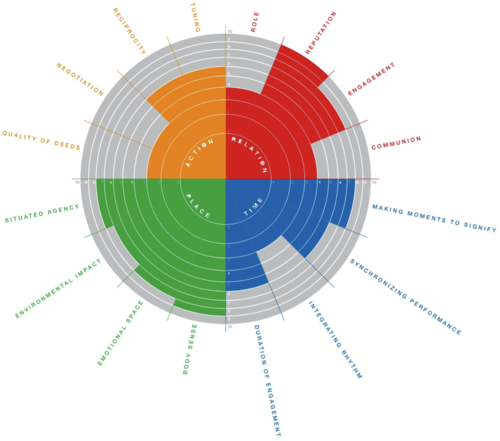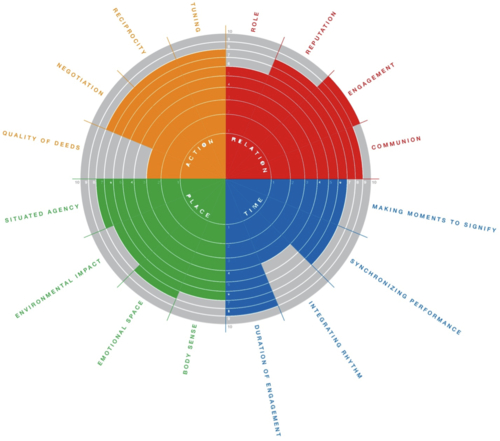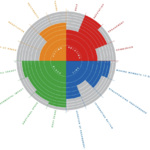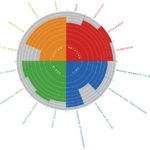3. Future System
3.1.Actors
Actors
The current target groups are both tourists and Texelaars of 45 years and older. It is assumed that the population of Texelaars will remain approximately the same. The group of people of 20 to 40 years old will probably stay the smallest group because of the study and career opportunities, which are not so present at Texel. It is expected that the migration numbers of people moving from and to Texel will be the same and the number of inhabitants is also not expected to change. Therefore, the focus for future public space for Texelaars remains on the age group of 45 years and older.
However, the age group of tourists could be influenced more easily. They stay at the island for a couple of days instead of living there, which results in totally different needs. The tourists currently visiting Texel, consist especially of tourist from the age group of 45-64 years old. The second largest group is the group of teenagers. A group with a lot of potential is the age group between 18 and 44 year. The age group of 18-25 years is almost not visiting Texel. However, the Texelaars probably do not mind the absence of that age group because they can cause some disturbances (especially during the night). Families with children however, are less disruptive and therefore very welcome at Texel. Besides, parents want to do activities with their kids. An educational activity aligns perfect with the vision.
The majority of the tourists come from the Netherlands. Also a lot of Germans visit the island. However, if Texel becomes a pioneer for sustainable development, it would be desirable if people from other (surrounding) countries visit Texel as well.
Problem definition
No problem definition was defined from the current public space due to absence of knowledge about the public space of Texel. However, it is possible to state that the future public space should fulfil an educational function or a function that supports the education about Texel its sustainability.
The age group of people of 45-64 years has already a kind of bonding with Texel. It is not expected that this bonding will decrease because of the measures that will be implemented for Texel as a sustainable pioneer. Therefore the focus will be on the families with children. The challenge for this sub-system is to attract families to come visit Texel and learn something about sustainable development by the implementation of sustainable public space.
Needs and interests
In the previous paragraph conclusions are drawn about the actors and the problem definition. The goal is to attract families with children to come visit Texel and learn something about sustainable development. Some aspects that could attract families are:
- Activities (especially for kids)
- Safe accommodation
- Possibilities for the kids to play
- Beaches and nature
- (Public) spaces where interaction can take place
- Comfort (including thermal, social, etc.)
- Restaurants
Families do need a car to visit Texel because of the kids and the luggage they need to carry with them. This requires enough space on the ferry, accessible accommodations and parking lots.
Besides, a YUPTA analysis was developed in order to determine which is the current and future situation of local people and tourist regarding public space. This analysis is going to help to determine the goals that we want to achieve within this project.
3.1.1.YUTPA ANALYSIS
YUTPA ANALYSIS – TOURIST
The YUTPA framework, acronym for being with You in unity of Time, Place and Action, sheds light on specific presence configurations in which a person performs presence with YOU, in the NOW, being HERE, with a specific potential to DO certain things. (Nevejan 2014)
In this analysis, we understand the value of design in relation to presence of a person in terms of experience that defines an individual’s wellbeing and survival. From the point of view of public spaces, we define the YUTPA analysis for two kinds of users of public space, i.e the tourists who are temporary but important, and the Texelaars, the local community who define what implications are allowed to make changes to their “home land”.
The following analysis is subjective indicators and not objective calculated outcomes for facilitating conversation about a specific presence of design
We use this analysis to define the experiences we think are important or not priority for the users. This furthers us to emerge into a conceptual framework where we can tackle infrastructures relating to social, economic and technical aspects of sustainability in public spaces.
Relation: the tourists visiting Texel have one role: as tourists. Their role as a doctor or a coast guard in other place is not so relevant as their reputation in this place. In public places of Texel, on an average, the tourists will be well behaved and display a kindness which we perceive as people with good reputation. In essence, this defined the activities they can perform, and hence a high engagement. This also defines what level of sustainable intervention needs to be designed. Since the people have a high rep, they will be more aware and concerned about avoiding unsustainable solutions, for example, dumping waste bottles on the streets, as observed in touristic destinations in mainland. However, they do not truly connect to the importance of for example the historic sights. Hence, they do not exactly share the same meaning with the Texelaars; hence the communion is low.
Time: as people in public spaces, it is relevant to have a large amount of duration of engagement. As tourists on a holiday, the time they spend in activities is more important and adds value to their experience. They also want some level of privacy; hence, they are not outdoor 24x7. However, it is important to make some special moments that are of significance and that bring them again to the island. Their engagement with public spaces has neither a need to be synchronized nor integrated with the daily activities of the local people.
Place: the experience for a tourist has a direct relation the place. What they feel about being there, the quality of activities and the time spend on them, how it makes them feel about themselves is all-relevant for a public space. This defines the quality of the experience, and well being they observe on the island. The emotion attached to how it makes them feel or what they can do in the place is the key factors of the experience. Hence, the situated agency is important but the body sense plays a key role, as it is the connecting factor to the emotional space and situated agency. Of course, what they do/ products they require have a direct relation to the environmental impact.
Action: the quality of deeds relating to a temporary individual in a public space relates to activities that he or she performs for leisure. These are different from activities they would need to do to synchronize performance, and also less relevant for their experience as a tourist. Also as a tourist their experience of wellbeing is far from a negotiation they would need to perform on a regular basis. However, when we involve some amount of tourist experience with the locals, we get a higher level of give and take relationship, where each party can learn from the other.
YUTPA ANALYSIS – TEXELAARS
Relation: the Texelaars vary in age groups. The relation to one another, in respect to public space is mainly familial, friendly and in rare extended cases, professional. It is thus a place where family friends and sometimes colleagues meet for a hang out or a good time together. The role they play, as a family person or a friend, defines their actions, and hence role is given high importance. Also, since Texelaars are the primary users of the public place in summer and winter, their engagement to the space is very important. This also leads to a very high communion.
Time: Different people have a different preference to use the public spaces, at their convenient time. In essence, it is available for use during its opening hours for all the time that it is open. Hence, it is as high as possible. The rhythm of the users is to some extent affected by the rhythm of the service providers, for example, of the bakery or the library. It also sometimes is instrumental in making moments to signify that will add value to the Texelaars’ experience.
Place: The Texelaars are the ones who will use this space in summer and winter. For them, this public space should not lose its meaning with the seasonal changes in weather conditions. Hence, it is important to include them in every stage of designing. The locals should have some awareness about how they feel about their bodies, which defines, for example, how they dress. But it is irrelevant sometimes if they are just for a regular outing. The emotional space will also be high as their local monuments would remind them of their history and the natural systems will keep them integrated with the ecology. In this sense, they will have an environmental impact depending on the activities they do in the public spaces.
Action: it is important for the Texelaars that they have a fair trade and they get back what they invest in, in terms of both cost and deeds. This necessarily means that these have to be in tune for Texelaars with each other; for example, the installation of a sustainable option should not destroy the quality of someone else’s life. In this sense, it does not matter what sustainable options the neighbor intends to install, hence the quality of deeds does not have so much relevance as the reciprocity or negotiation.
To conclude, we analyze two types of actors: the tourists and the Texelaars. We observe that all the four actions of action, relation, time and place are very important to Texelaars in terms of public space. However, for the tourists, memories play an important role, hence the time they spend and the place they are in, these factors have primary importance. Since public space is a common ground for the locals and the tourists, it is important that there is some interaction of tourists and locals, so they spread their local knowledge and goods to the mainland, but it is also important to preserve the local culture and not be drowned by the globalization that is generated by the influx of the tourists. A sustainable solution should find a good balance between these two aspects.
3.2.Landscape
The aim is that each village show their own identity through landscape. Regarding that it is proposed to recover the old nature landscape. In fact, Texel is famed for its large numbers of orchids and some unusual plants, typical of the Wadden Islands because they prefer the salt marshes. The area of the Wadden is a nursery and provides shelter and an inexhaustible source of food for birds, fish and marine mammals. Therefore, old plants and landscape are being reincorporated to the island and new and pleasant walking paths and cycle rides are introduced to the public space within the island for locals and tourists. (Texel.net, 2014)
3.3.Technologies
The future of public space as our proposal would be multiple use of the same space available. The strategy is to use “Circular Flow Land Use Management” sustainable criteria based on “avoid”, “recycle” and “compensate”. It is also propose to use the concept of “placemaking” to further explore possibilities of shaping the culture of sustainability awareness.
While environmentalism has challenged human impact on our planet, it is not the planet that is threatened but humanity’s ability to live viably here. Placemaking is the communal capacity, for people to thrive with each other and our natural world, which is dedicated to encouraging and empowering people to take ownership over and contribute to the world beyond their private property and work together to improve them. It is the common sense process through which the human places we most value are created and sustained. (PPS, placemaking)
In essence, the future public spaces will be not one space for one function but rather one space for a multitude of changing functions. These spaces are then defined by what kinds of functions the tourists and mainly the locals would want to ensure that these spaces are most active and efficiently used.
“Circular Flow Land Use Management” and “Placemaking” criteria promote the use of the current technologies instead of waiting for the development of one, in order to ensure fast and instant applications. This involved a multitude of possible technological interventions. Smart lighting and solar power could be possible options of smart technologies in application. However, simple techniques such as glow paints instead of bright light, especially at the ecological fringe will be effective. The technologies will address harmony of ecological, social and economic aspects.
Places for initiatives for social awareness will be a key goal for use of these technologies.
This will take into place by two steps: first educating the people of the interventions needed, next inviting for realistic design proposals, and lastly, taking a public vote on the solutions presented. The approach of this development system will be the use of back-casting method, meaning that the desired future will be worked out backwards by identifying policies and programs and then connect future to present
These approaches combine
1. The involvement of a broad range of stakeholders and actors from different societal groups including government, companies, public interest groups, and knowledge bodies, not only when defining the problem but also when searching for solutions and developing shared visions.
2. Incorporating not only the environmental component of sustainability, but also its economic and social components.
3. Taking into account the demand side and the supply chain as well as related production and consumption systems. (adapted from J.Quist, 2013)
The agenda includes channelizing human, social, economic, infrastructure and cultural capital into the generation of place capital (adapted from The Benefits of place)
3.4.Rules and regulations
'Nature for people, people for nature'.
Currently, more and more initiatives between public and private parties are coming off the ground and benefiting local economies. That is why the Dutch Government set out a plan to realize a national ecological network made up of large, interlinked nature areas. The aim is the network comprises 750,000 hectares, or roughly 18% of the Netherlands’ area by 2018. In fact, the national ecological network will form the core of Dutch nature. Hence, it will enable the sustainable preservation of both common and rare plant and animal species in the Netherlands.
In order to develop a sustainable island and regarding public space some aspects have to be taken in account for the development of future policies. Nowadays, public space is a place for social and economic exchange, such as, street markets, car boot sales and community centers, all of which need consideration in local public space strategies.
First, future policies and proposals for public space should be based on a better understanding of people’s use of existing spaces and places, particularly street markets and traditional high streets. Thus, integrating economic, social and cultural aspects.
It is important to develop inclusive policies that take in account local attachments to existing places and activities. Besides, it is important to generate playful spaces. Children still need opportunities for outdoor play in neighborhood spaces, not just fixed equipment playgrounds, in order to participate in communal games, which in turn create a sense of belonging and attachment to local places. Some studies suggest that successful public spaces should build on the large degree of self-regulation of public behavior that already exists. What is more, better coordination is required to address the multiple concerns of accomplishing design, efficient management and maintenance and social cohesion and inclusion.
On the other hand, regarding public space management in Texel, it is important to take in account some aspects for example wildlife management. Therefore, it is propose to include within the policy of the place a Geocaching management, where people can integrate education, recreation, and nature, but some regulations are needed in order not to affect any wild ecosystem. (Worpole, 2007) (SamenwerkingsverbandNationaleParken, 2014) (Ecomare, 2014)
3.5.Interrelations
As it was mentioned before the aim is to improve public space within the island through showing and promoting the identity of Texel and its seven villages, so people are going to feel attached to it. What is more, as it was mentioned before, there are two main important actors regarding public space within the island, local people and tourists. Hence, it is proposed to promote a new approach of public space by combining education, culture and nature. The strategy is to identify some identity aspects within each village and connect them through interactive connections that combine education, culture and nature.
Bibliography:
PPS, placemaking, (http://www.pps.org/reference/placemaking-as-a-new-environmentalism/)
The benefits of place, http://www.pps.org/reference/place-capital-the-shared-wealth-that-drives-thriving-communities/
J.Quist, 2013, Backcasting and Scenarios for Sustainable Technological Development, Delft university of Technology.
Worpole, K. &. (2007, 04 23). The Social Value of Public Space . Retrieved 12 5, 2014, from Joseph Rowntree Foundation: http://www.jrf.org.uk/publications/social-value-public-spaces
Ecomare. (2014). Dutch Nature policy. Retrieved 12 5, 2014, from Ecomare: http://www.ecomare.nl/en/encyclopedia/man-and-the-environment/nature-management/nature-policy/
SamenwerkingsverbandNationaleParken. (2014). Dutch Nature Policy. Retrieved 12 5, 2014, from Samenwerkingsverband Nationale Parken: http://www.nationaalpark.nl/documents/nationale-parken/nederlands-natuurbeleid.xml?lang=en
Texel.net. (2014). Nature Reserve. Retrieved 12 12, 2014, from Texel: http://www.texel.net/en/about-texel/nature/nature-reserve/



